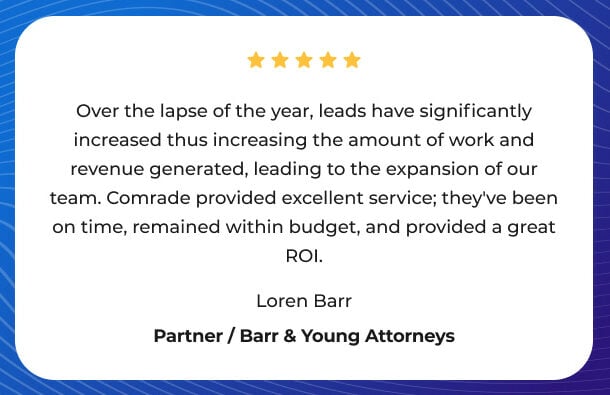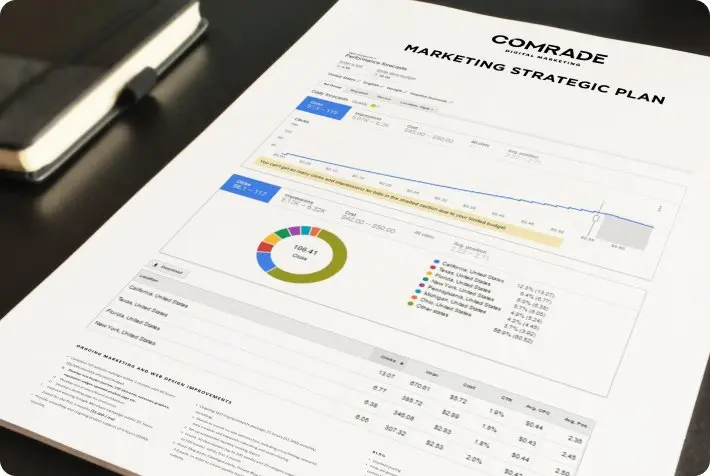As a lawyer exploring YouTube marketing for law firms, you’ve invested years in your education and career. The last thing you want is potential clients hiring someone else because they can’t find your legal YouTube content when they need help.
Right now, someone in your area is searching for legal advice on YouTube—whether it’s about a personal injury claim or how to create a will. If your law firm isn’t there with the answers, you’re missing out on a huge opportunity.
With over 2 billion active users, YouTube is the second-largest search engine in the world. But surprisingly, many law firms still rely on outdated marketing methods like billboards and print ads, missing out on the power of digital content.
In this guide, we’ll show you how to tap into YouTube for lawyers to attract the right clients, boost your credibility, and grow your practice—without having to become a full-time video producer. Let’s get started.
Part of Our PPC Guide for Law Firms
Explore each part of our complete guide to mastering PPC for law firms:
1. Strategy Development: Building Your Law Firm YouTube Channel Foundation
Before you hit record on your first video, make sure you have a rock-solid strategy. In the world of digital marketing for lawyers, randomly posting about legal topics won’t attract your ideal clients. You need a focused, goal-driven content plan that aligns with your firm’s objectives and speaks directly to your target audience.
Define Your YouTube Goals and Success Metrics
Start by getting crystal clear on what you want YouTube to accomplish for your firm. Ask yourself:
- Are you looking to generate more consultations for a specific practice area?
- Do you want to establish yourself as the go-to expert in your local market?
- Is your goal to educate prospects so they come to you pre-qualified and ready to hire?
Once you know your “why,” set measurable targets. For instance, it might be 10 new client inquiries per month from YouTube, or growing your subscriber base to 1,000 local viewers within six months. Whatever your goals, make them specific and trackable.
Identify Your Target Audience’s Video Habits
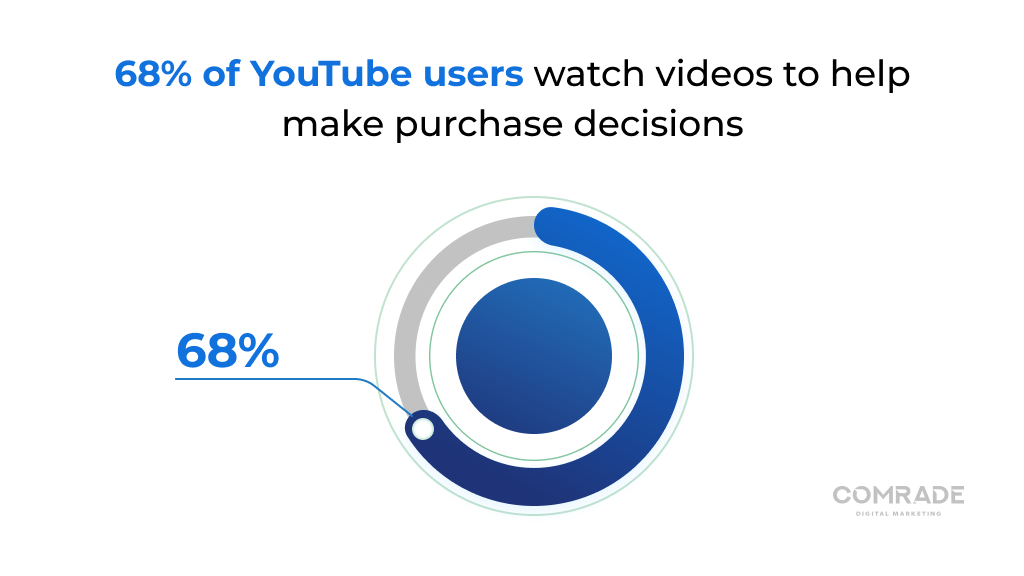
Your ideal clients are already on YouTube — but what are they watching? Understanding their search behavior is crucial. Research shows that 68% of YouTube users watch videos to help make purchase decisions, and legal services are no exception.
Use tools like YouTube’s search bar autocomplete, Google Trends, and AnswerThePublic to uncover what legal questions people in your area are asking. For instance, if you’re a family law attorney in Dallas, you might discover people are searching for “Texas child custody laws explained” or “how much does divorce cost in Dallas?”
Pro tip: Check your intake forms and client FAQs. The questions that come up repeatedly during consultations are perfect video topics — they’re proven client concerns.
Analyze Your Competition (Then Beat Them)
Here’s the good news: Most law firms either aren’t on YouTube or are doing it poorly. This creates a massive opportunity for you to dominate. But first, see what’s already out there:
- Search for legal professionals in your practice area and location
- Note which videos have the most views and engagement
- Identify gaps in their legal content (what questions aren’t they answering?)
- Look at their video quality, length, and presentation style
Tools like VidIQ or TubeBuddy can show you exactly which keywords your competitors rank for and how their videos perform. If local firms are getting thousands of views on basic FAQ videos shot on smartphones, imagine what you could do with a proper strategy.
The bottom line: Your YouTube for lawyer strategy should position you as the most helpful, trustworthy legal resource in your market. When you provide genuine value first, the clients will follow.
2. Channel Setup and Optimization: Your Digital Law Office
Your law firm YouTube channel is more than a video repository — it’s a powerful legal YouTube marketing tool and extension of your firm’s brand and often the first impression prospective clients have of you. A poorly optimized channel screams “amateur hour,” while a professional setup builds instant credibility.
Create a Channel That Commands Authority
First impressions matter, especially in law. Your channel should look as professional as your office:
- Channel Name: Use your firm name or “YourName Law” for easy recognition
- Custom URL: Claim your custom URL (youtube.com/c/YourFirmName) once eligible
- Channel Art: Design a banner that includes your logo, practice areas, location, and contact info
- Profile Picture: Use your professional headshot or firm logo — consistency is key
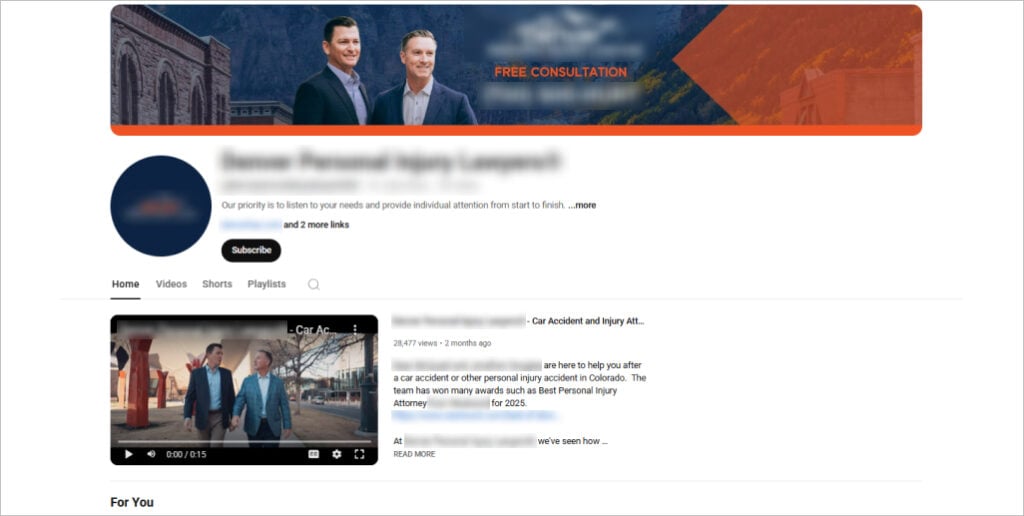
Remember, 90% of top-performing lawyers on YouTube have fully optimized channel pages. Don’t give viewers a reason to click away before watching your content.
Optimize for Legal Keywords and Local Search
YouTube is a search engine, and your channel description is prime real estate for relevant keywords. Write a compelling 1,000-character description that:
- Clearly states what legal services you provide
- Mentions your location multiple times naturally
- Includes a strong call-to-action with your phone number and website
- Uses keywords your clients search for
Example: “Smith & Associates is Denver’s trusted personal injury law firm, helping accident victims get maximum compensation for 20+ years. If you’ve been injured in a car accident, slip and fall, or workplace incident in Denver, Colorado, we’re here to help. Call (555) 123-4567 for a free consultation or visit SmithLawDenver.com.”
Organize Content with Strategic Playlists
Playlists aren’t just for organization — they’re powerful SEO tools that keep viewers watching longer. Create playlists around:
- Practice areas (“Colorado DUI Law Explained”)
- Client journey stages (“After Your Accident: Next Steps”)
- Location-specific content (“Denver Personal Injury Lawyer FAQs”)
- Case results and testimonials
Name your playlists with searchable keywords, not clever titles. “Car Accident Help Denver” beats “Crash Course” every time.
Practical Advice: Feature your most important playlist in your channel trailer spot. This ensures new visitors immediately see your most valuable content.
3. Attorney YouTube Content Creation: Turning Legal Knowledge Into Engaging Videos
Here’s where most lawyers freeze up: “But I’m not a YouTuber!”
Good news — you don’t have to be. Effective content marketing for lawyers isn’t about flashy videos or viral fame. It’s about delivering honest, clear answers from a real, trustworthy attorney. That’s your edge.
Choose Video Topics That Attract Qualified Clients
The best video topics answer the exact questions your ideal clients are asking. Start with these proven formats:

- Legal FAQ Videos: Address common questions like “Do I need a lawyer for a minor car accident?” or “How long does probate take in [your state]?” These evergreen topics consistently attract viewers.
- Process Explainers: Walk viewers through legal processes step-by-step. “What Happens at Your First DUI Court Date” or “Filing for Divorce in Texas: Complete Timeline” positions you as the helpful expert.
- Client Success Legal Stories: With permission, share anonymized case results. “How We Won a $500K Settlement for a Slip-and-Fall Victim” builds credibility while staying ethical.
- Legal News Updates: Comment on recent law changes or high-profile cases in your area. This timely content can attract immediate traffic.
By aligning your content with the specific needs and questions of your audience, you can ensure that your videos continue to engage and inform.
Script for Clarity, Not Perfection
You don’t need a teleprompter, but you do need structure. Use this simple framework:
- Hook (0-15 seconds): State the problem and promise a solution
- Introduction (15-30 seconds): Briefly introduce yourself and your credentials
- Main Content (2-5 minutes): Deliver value with clear, jargon-free explanations
- Call-to-Action (30 seconds): Tell viewers exactly what to do next
Example opener: “If you’ve been arrested for DUI in Phoenix, the next 30 days are critical for protecting your license. I’m Attorney Jane Smith, and in this video, I’ll walk you through exactly what to do — and what mistakes to avoid — after a DUI arrest.”
Maintain Professionalism While Being Personable
Your videos should feel like a consultation, not a lecture. Here’s how to strike the right balance:
- Speak directly to the camera as if talking to one person
- Use plain English — save the legal jargon for the courtroom
- Share relevant examples (anonymized) to illustrate points
- Be empathetic — remember, viewers are often stressed and searching for help
Technical tip: You don’t need expensive equipment. A modern smartphone, good lighting (natural window light works great), and clear audio (invest in a $50 lapel mic) are enough to create professional content.
Remember: Every video is an opportunity to demonstrate your expertise and build trust before a potential client ever calls your office.
4. SEO and Publishing: Optimizing Your Law Firm Video Marketing
Great content means nothing if no one sees it. Without SEO for lawyers, your videos risk gathering dust while competitors dominate search results—and land more clients.
Master YouTube SEO Fundamentals
Getting your legal video in front of the right viewers on YouTube takes more than just hitting upload. The algorithm needs context, and it favors content that keeps people engaged.
Focus on these essentials for better visibility:
- Write video titles that blend keywords with emotion. “Georgia Child Custody Laws 2025: What Fathers Need to Know” is far more compelling than “Child Custody Info.” Keep it under 60 characters and front-load keywords.
- Max out your video description. Start with a punchy 125-character summary, then add timestamps, contact info, naturally placed keywords, and links to helpful pages on your site.
- Use a smart mix of tags. Include general terms like “DUI lawyer” alongside specific ones like “Denver DUI attorney” or your firm name. TubeBuddy can help you find what’s trending.
With the right setup, YouTube will better understand—and recommend—your video to the right audience.
Craft Compelling Thumbnails
Your thumbnail is your billboard — it needs to stop scrollers in their tracks. Effective legal video thumbnails include:
- Your professional headshot (builds trust)
- Clear, bold text highlighting the key benefit
- Contrasting colors that stand out
- Consistent branding across all videos
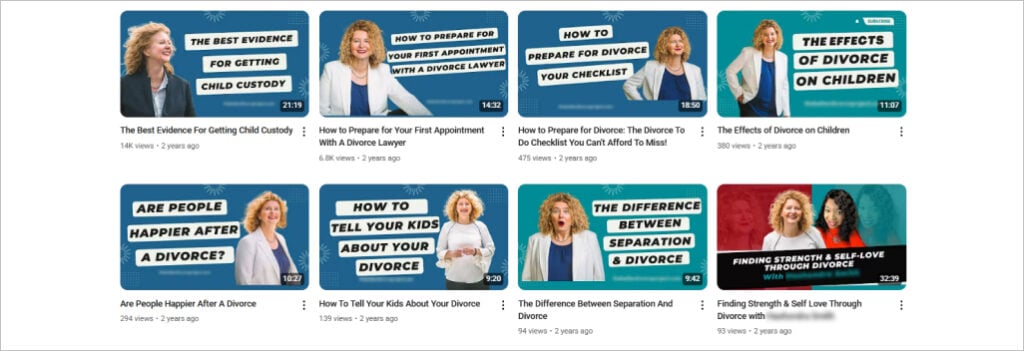
A/B test different thumbnail styles to see what resonates with your audience. Many lawyers find that thumbnails with concerned facial expressions and question-based text (“Arrested for DUI?”) perform best.
Strategic Calls-to-Action That Comply
Every video needs a clear next step, but stay within ethical guidelines:
- “If you’re facing charges in Denver, visit our website for a free case evaluation”
- “Download our free guide to protecting your rights after an accident”
- “Subscribe for weekly updates on Colorado law changes”
Place CTAs both verbally in your video and your description. Include clickable timestamps so viewers can jump to the information they need most.
Publishing tip: Consistency matters more than perfection. Whether it’s weekly or monthly, stick to a schedule. YouTube rewards the best lawyer Youtube channels that publish regularly with better visibility.
5. Promotion and Distribution: Amplifying Your Reach
You’ve created valuable content—now it’s time to get it seen. With smart YouTube marketing for law firms and targeted SEM for attorneys, you’ll drive qualified leads directly to your practice and amplify your impact.
Leverage Your Existing Digital Assets
Your website is YouTube video gold waiting to be mined. Embed relevant videos on:
- Practice area pages (DUI video on your DUI services page)
- Blog posts expanding on video topics
- FAQ sections with video answers
- Your homepage or about page for credibility
This cross-pollination improves your website’s engagement metrics while giving videos more views — a win-win for SEO.
Social Media Distribution That Works
Don’t just dump video links on social media. Create powerful platform-specific strategies:
- LinkedIn: Share videos with professional commentary about legal trends. “New overtime laws affecting Colorado employers — here’s what you need to know” positions you as a thought leader.
- Facebook: Post videos in local community groups (where allowed) when answering legal questions. Always provide value first, promote second.
- Instagram: Create 60-second video clips highlighting key points from longer YouTube videos. Use relevant hashtags like #DenverLawyer or #ColoradoDivorceAttorney.
Thoughtful distribution turns your video content into an engine for credibility, visibility, and connection, where it matters.
Email Marketing Integration
Your email list is full of people who already trust you. Share monthly video roundups, embed videos in newsletters, or send exclusive “subscriber-only” content to drive engagement.
Smart Paid Promotion
YouTube ads can accelerate growth when done right:
- Target by location (your city/county)
- Focus on “in-market” audiences searching for lawyers
- Use skippable in-stream ads to build awareness
- Create separate campaigns for each practice area
Start with a modest budget ($500-1,000/month) and scale what works. Many firms see positive ROI within 60-90 days.
Community Engagement Builds Trust
Responding to comments isn’t just polite — it’s powerful legal marketing. When you answer questions thoughtfully (while noting you can’t give specific legal advice), you demonstrate accessibility and expertise. Plus, engagement signals boost your video’s ranking.
Set aside 15 minutes after publishing to respond to early comments. This initial engagement surge tells YouTube your content is valuable.
6. Tracking and Improvement: Turning Data Into Growth
Social media marketing for lawyers isn’t just about creating videos — it’s about results. Ignoring YouTube analytics is like going to trial without evidence. Know what to measure, and use it to refine your strategy.
Monitor Metrics That Matter
Don’t chase views—focus on the metrics that grow your business:
- Watch Time – If viewers drop off after 30 seconds, YouTube notices. Aim for at least 50% average view duration to stay in the game.
- CTR – Your title and thumbnail need to grab attention. A 4–6% CTR is strong for legal videos; under 2% means it’s time for a refresh.
- Traffic Sources – Know where views come from—search, suggested, or external—and lean into what’s working.
- Audience – Make sure you’re reaching the right people. If you’re a Denver lawyer pulling views from overseas, something’s off.
Stick to data that drives real results, not just vanity.
YouTube Analytics Deep Dive
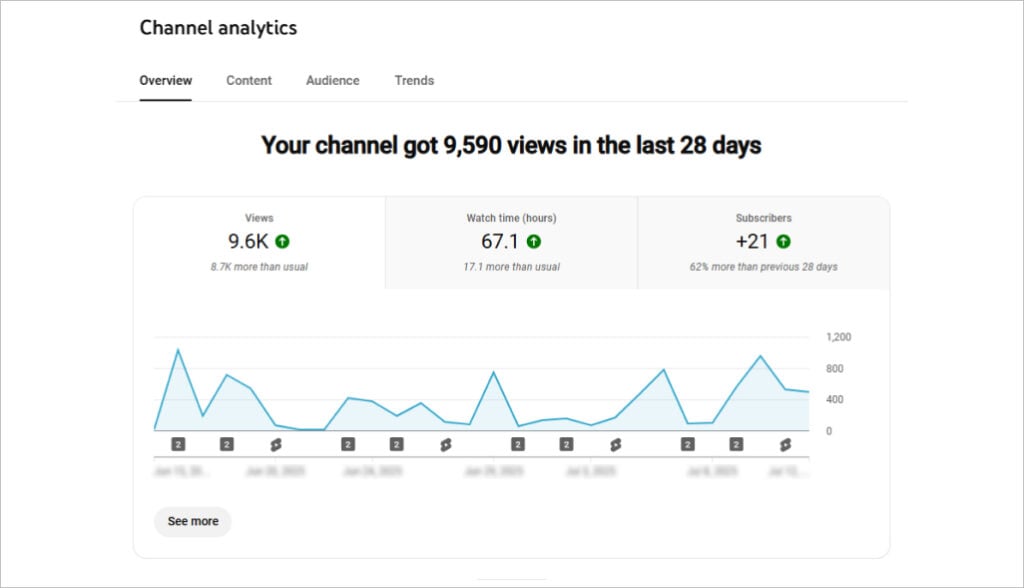
Inside YouTube Studio, pay special attention to:
- Real-time data: See how new videos perform in the first 48 hours
- Search terms report: Discover exactly what phrases bring viewers to your content
- Audience retention graphs: Identify where viewers drop off and why
- End screen click rates: Measure how well you’re driving action
Pro tip: Compare successful videos to underperformers. Often, small differences in titles, thumbnails, or opening hooks make huge impacts.
Test, Learn, and Optimize
Every video is a learning opportunity. Run systematic tests:
- A/B test thumbnails: Try different styles and track CTR changes
- Experiment with video length: Some topics need 10 minutes, others work in 3
- Try different formats: Talking head vs. screen share vs. whiteboard
- Vary posting times: Find when your audience is most active
Document what works in a simple spreadsheet. Over time, you’ll develop a winning formula unique to your firm and market.
Continuous Improvement Strategies
Based on your data, make strategic adjustments:
- If retention drops at certain points, tighten your scripts
- If search traffic is low, research better keywords
- If comments request specific topics, create that content
- If certain playlists outperform, expand those practice areas
Remember: YouTube success isn’t about going viral — it’s about consistently providing value to your target audience. One full video that brings in a high-value case pays for years of content creation.
The firms winning on YouTube aren’t necessarily the biggest or best-funded. They’re the ones who commit to helping potential clients, track what works, and keep improving. With these helpful tips, you’ll build a YouTube presence that generates real results for your practice.
The Verdict Is In: YouTube Works for Lawyers Who Work It
Lawyers looking to build their practice and reach new clients can greatly benefit from a strong YouTube marketing strategy. By creating valuable, informative content and optimizing videos for search, you can increase visibility and establish trust with potential clients.
Comrade Digital Marketing specializes in helping law firms navigate the complexities of online marketing. Our team is experienced in crafting customized YouTube strategies that drive results and grow your client base.
Let us help you transform your YouTube presence into a powerful lead-generation tool. We’ll work with you to create content that resonates with your audience and sets you apart from competitors.
Ready to get started? Book a consultation with Comrade Digital Marketing today and take the first step toward mastering YouTube for your law firm!
Frequently Asked Questions
-
What are some ethical or legal boundaries lawyers must keep in mind when creating YouTube content?
Lawyers must avoid giving specific legal advice in videos to protect both themselves and viewers interested in general information, not personal counsel. The American Bar Association also warns against creating misleading content or violating client confidentiality. Maintaining a trusted voice requires careful attention to ethical guidelines.
-
What types of video content resonate most with legal audiences on YouTube?
Content like reaction videos to courtroom clips, explainer videos breaking down complex legal concepts, and commentary on pop culture legal cases tends to gain traction. Law students and other lawyers alike also enjoy insightful videos featuring legal analysis and commentary on recent legal issues.
-
What equipment and software do lawyers need to create professional-quality videos?
A good camera and microphone, basic lighting gear, and simple editing software like Final Cut Pro or Adobe Premiere are enough to get started. Even the lead attorney in a criminal defense firm, who has been in place for months or years, can grow with these tools, especially when balancing the business side of attracting more clients.
